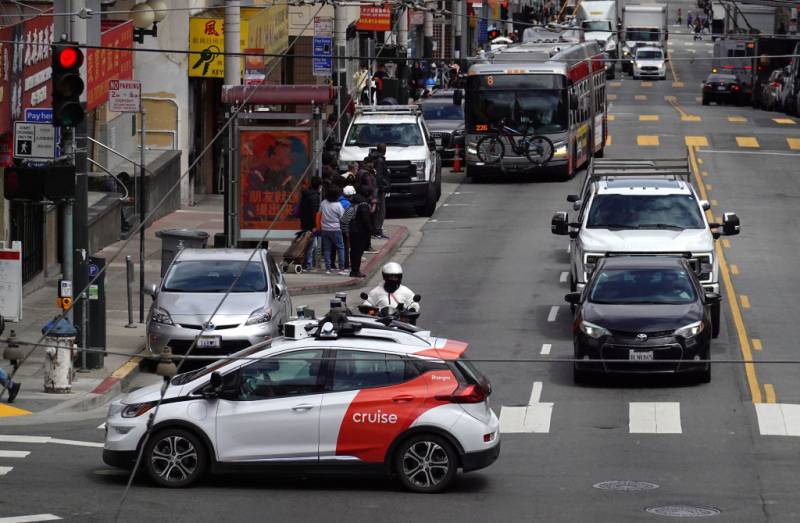Updated 11:15 a.m. Wednesday
It’s the end of the road for one driverless vehicle company in San Francisco. At least for now.

Updated 11:15 a.m. Wednesday
It’s the end of the road for one driverless vehicle company in San Francisco. At least for now.
On Tuesday, the California Department of Motor Vehicles announced that it suspended autonomous vehicle deployment and driverless testing permits for Cruise because of an early October incident in which a pedestrian was seriously injured.
The DMV said it was lifting Cruise’s permits indefinitely due to safety concerns and because the company failed to disclose full details of the Oct. 2 collision at 5th and Market streets.
“Public safety remains the California DMV’s top priority, and the department’s autonomous vehicle regulations provide a framework to facilitate the safe testing and deployment of this technology on California public roads,” the DMV said in a statement. “The DMV will not approve until the company has fulfilled the requirements to the department’s satisfaction.”
The California Public Utilities Commission, which regulates for-hire transportation services, quickly followed suit. The commission issued an order suspending Cruise’s permit to carry members of the public, whether or not they’re paying for rides.
Both the DMV and CPUC said they are investigating.
General Motors-owned Cruise is one of two robotaxi companies in San Francisco that the CPUC authorized in August to operate driverless vehicles in the city. The other is Waymo, which is owned by Google’s parent company, Alphabet.
The DMV’s order on Tuesday only applies to Cruise. The state agency said it has found Cruise’s autonomous vehicles are unsafe and that the company has allegedly “misrepresented” safety data about the cars.
Cruise said it learned of the DMV’s decision on Tuesday at 10:30 a.m. PDT and will stop all driverless vehicle operations in San Francisco.
The suspension follows increasing public pushback over Cruise and other driverless vehicles that operate in San Francisco and a handful of recent crashes involving Cruise robotaxis.
One of those incidents was a hit-and-run in early October, where a human driver struck a pedestrian crossing Fifth and Market streets, hurling them into the street in front of a Cruise robotaxi. The driverless vehicle then rolled over and dragged the pedestrian forward as it attempted to pull over to stop because it detected a collision, reports from Cruise and witnesses say.
“Our teams are currently doing an analysis to identify potential enhancements to the AV’s response to this kind of extremely rare event,” a Cruise spokesperson said in an email to KQED.
The DMV cited the Oct. 2 accident in its order of suspension sent to Cruise on Thursday, obtained by KQED.
The agency said Cruise “failed to disclose that the AV executed a pullover maneuver that increased the risk of, and may have caused, further injury to a pedestrian,” the letter sent to Cruise reads.
After the accident, the National Highway Traffic Safety Administration said it would investigate Cruise, writing in an Oct. 16 memo that the company “may not have exercised appropriate caution to around pedestrians in the roadway.”
The San Francisco city attorney’s office has asked the CPUC to revisit its August decision to allow Cruise and Waymo to expand operations without first requiring them to meet certain safety requirements.
City Attorney David Chiu told KQED his office has not yet received any response from CPUC. He said that the DMV’s actions on Tuesday “vindicates the public safety concerns our city has been raising for months.”
“We need Cruise to step forward and hopefully take a different turn here and engage with the city transparently with real accountability,” Chiu said regarding allegations from the DMV that Cruise failed to disclose how the driverless vehicle drove 20 feet with the victim beneath the car. “What was suggested in the DMV letter is troubling.”
Teamsters Western Region International Vice President Peter Finn called the DMV’s decision “a step in the right direction,” but that it’s “too little too late.”
“Regulatory bodies should have enough foresight and operational savvy to know that the responsible thing to do is to make sure that automated driving systems are safe before they are introduced to the general public — not after they are introduced, and certainly not after driverless cars have caused traffic jams, injuries, and obstructions to first responders,” Finn said in a press release.
The Teamsters have protested efforts by Cruise to expand driverless vehicles in California, citing labor and safety concerns. The group supported Assembly Bill 316, which would have required human operators in cars and trucks weighing more than 10,000 pounds and easily passed in both houses of the Legislature. Gov. Gavin Newsom vetoed the bill.
Assemblymember Phil Ting, D-San Francisco, said he’s taken a Cruise ride and found it to feel safe but supports the DMV’s decision.
I applaud @CA_DMV for their oversight role in making sure San Franciscans are safe on our streets. I took my 1st @Cruise ride last week & found it to be safe/cautious. I’ll continue to monitor the situation to ensure safety is prioritized before the company’s cars may return. pic.twitter.com/DCExNWRnOc
— Phil Ting (@PhilTing) October 24, 2023
This is a developing story and will be updated.
Updated to add the California Public Utilities Commission’s suspension of Cruise’s permit to carry passengers.
To learn more about how we use your information, please read our privacy policy.